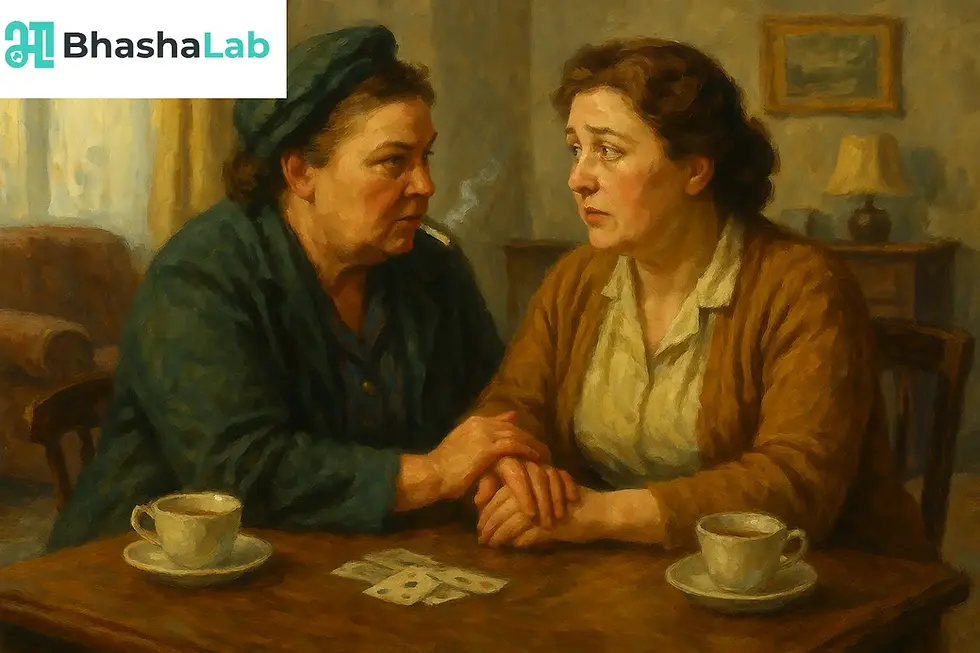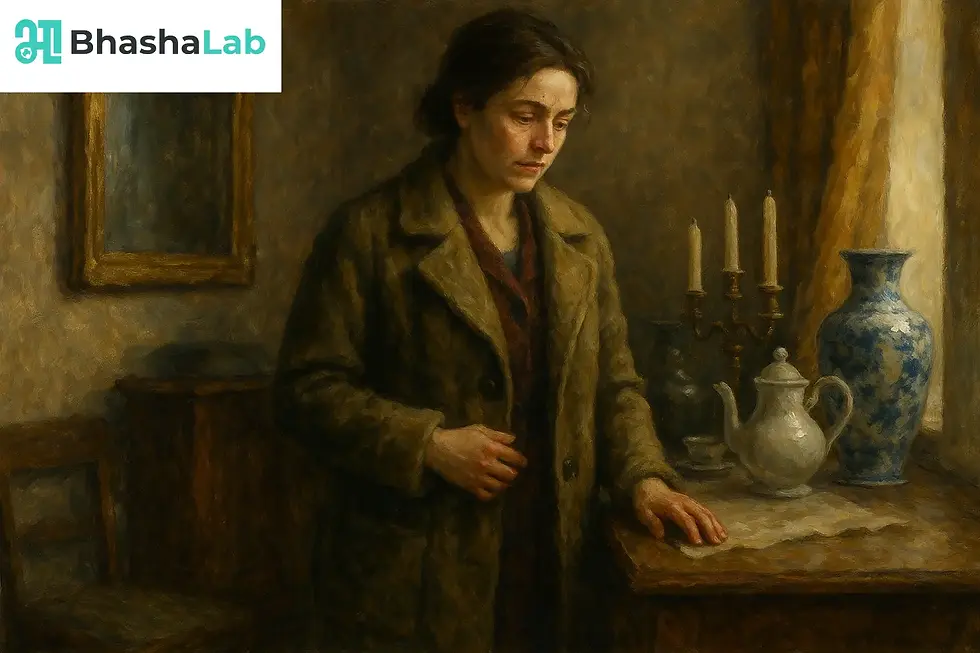3. Mother’s Day - Class 11 - Snapshots
- Jul 7
- 4 min read
Updated: Jul 8

Author: Masti Venkatesha Iyengar
Textbook: Snapshots
Genre: Short Story / Fiction
Summary
“Ranga’s Marriage” is a humorous and culturally rich short story narrated by a village elder from Hosahalli, Karnataka. It revolves around Ranga, the village accountant’s son, who returns from Bangalore after studying English. The villagers expect Ranga to have changed, but he remains humble and respectful. However, Ranga expresses his disinterest in early marriage, preferring to marry only when he finds a mature and suitable girl. The narrator, keen to see Ranga married, devises a clever plan using a village astrologer and a young girl named Ratna. He arranges a meeting where Ranga is smitten by Ratna, only to be told that she is already married. Disappointed, Ranga's change of heart is confirmed. Later, he discovers she is unmarried, and with the help of the narrator and a false astrological reading, Ranga is guided toward marriage. Eventually, Ranga and Ratna marry and have a son named after the narrator. The story uses wit and local colour to highlight the values of traditional Indian society and the blending of modern ideas with cultural roots.
Character Sketch
Ranga:
Ranga is an educated, well-mannered young man from a small village. Despite studying in Bangalore, he retains his humility and respect for traditions. Initially, he is influenced by modern ideas, especially about marriage, but his views evolve with gentle manipulation. He represents the clash and harmony between modernity and tradition.
The Narrator (Shyama):
He is a witty, traditional village elder who loves his culture and takes pride in his village. Observant and clever, he plays matchmaker with playful cunning. His narration is filled with humour, wisdom, and affection, and he successfully brings about Ranga’s marriage.
Ratna:
Ratna is a young, charming girl from a big town who can sing beautifully. Though shy and modest, she plays a central role in the narrator’s plan. She represents the ideal match—traditional yet attractive to Ranga.
Themes
Theme | Description |
Tradition vs. Modernity | The story contrasts modern views on marriage with traditional Indian customs. |
Matchmaking and Marriage | A light-hearted portrayal of arranged marriages and how elders influence them. |
Cleverness and Manipulation | The narrator's crafty matchmaking tactics drive the humorous plot. |
Rural Life and Community | The close-knit village culture and collective interest in personal matters. |
✨ Literary Devices
Device | Example | Effect |
Humour | Narrator’s sarcastic comments and village exaggerations | Engages and entertains the reader |
Irony | Ranga doesn't want to marry, yet falls for the narrator's plan | Highlights the twist in the story |
Foreshadowing | The narrator’s confidence about Ranga marrying Ratna | Builds suspense humorously |
Colloquial Language | Use of simple, conversational Kannada-influenced English | Adds local flavour and authenticity |
First-person narrative | Told by the village elder | Provides insight and comic tone |
Title Justification
The title “Ranga’s Marriage” is straightforward and aptly sums up the central event of the story—the journey of how Ranga, initially opposed to marriage, ends up getting married. The story, though humorous and rich in village flavour, is essentially about how Ranga's views on marriage are altered and how the narrator plays a pivotal role in it. The title highlights the transformation in Ranga’s beliefs and captures the essence of the plot.
One-Mark Questions
Why was Ranga’s return to the village a big event?
Ranga was one of the first boys from the village to study in Bangalore. The villagers were curious to see how English education had changed him.
What were Ranga’s initial views on marriage?
Ranga believed one should marry someone of their own choice and only after reaching maturity. He did not favour child marriage.
Who is Ratna?
Ratna is the eleven-year-old niece of Rama Rao. She is good at singing and becomes the narrator’s choice for Ranga’s bride.
How does the narrator trick Ranga using astrology?
The narrator collaborates with the astrologer to stage a prediction that Ranga will marry a girl named Ratna. This nudges Ranga toward accepting his feelings.
What is the name of Ranga’s son and why?
Ranga’s son is named Shyama, after the narrator. It reflects Ranga’s gratitude and the narrator’s pride in his
matchmaking.
Three-Mark Questions
How does the narrator influence Ranga’s decision to marry Ratna?
The narrator uses clever tricks to influence Ranga’s heart. He arranges for Ranga to hear Ratna sing and lets him fall for her. Later, he pretends that Ratna is already married, which disappoints Ranga. Then, using a fake astrology reading, he convinces Ranga that Ratna is his destined bride. Eventually, Ranga confesses his love, and they marry.
What role does the astrologer play in the story?
The astrologer is part of the narrator’s plan. He pretends to make predictions, already rehearsed with the narrator. His role helps build Ranga’s belief in fate and nudges him toward marriage. Though his role is small, it is crucial in convincing Ranga.
Describe the narrator’s attitude toward English education and culture.
The narrator is skeptical of English education and modern ideas. He believes they are unnecessary for village life. However, he uses his wit and traditional wisdom to handle Ranga’s modern views. His narration is laced with humour and irony, reflecting both pride and critique of changing times.
Value-Based Question
What message does the story give about balancing tradition and modernity in life?The story shows that while it is good to be modern and educated, one must also respect and value cultural roots. Ranga’s journey from modern ideas to accepting a traditional marriage reflects this balance. It teaches that elders' wisdom and love play an important role in guiding the younger generation. True happiness can come from embracing the best of both worlds—modern thinking and traditional values.
End
About BhashaLab:
BhashaLab is a dynamic platform dedicated to the exploration and mastery of languages - operating both online and offline. Aligned with the National Education Policy (NEP) 2020 and the National Credit Framework (NCrF), we offer language education that emphasizes measurable learning outcomes and recognized, transferable credits.
We offer:
NEP alligned offline language courses for degree colleges - English, Sanskrit, Marathi and Hindi
NEP alligned offline language courses for schools - English, Sanskrit, Marathi and Hindi
Std VIII, IX and X - English and Sanskrit Curriculum Tuitions - All boards
International English Olympiad Tuitions - All classes
Basic and Advanced English Grammar - Offline and Online - Class 3 and above
English Communication Skills for working professionals, adults and students - Offline and Online
Contact: +91 86577 20901, +91 97021 12044
Mail: info@bhashalab.com
Website: www.bhashalab.com





Comments